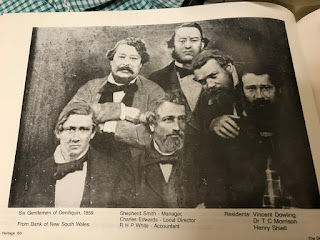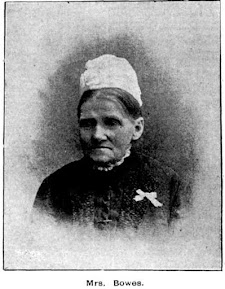A man at the very centre of death
It was the feature in last Sunday's Sydney
Morning Herald about an upcoming talk by Elliot Lindsay at Woollahra Hotel
about Murder and Mayhem in the eastern suburbs of Sydney in 19th Century that
made me recall a man at the very centre of the end of these people’s lives.
This talk is one of the first of a packed National Trust's Heritage Festival to
be held over the next month and there are many walks, talks and exhibitions
available; more on that later as I introduce you to a prominent but largely
forgotten member of Sydney Society.
HENRY SHIELL
Henry was born on 10 August 1826 on the island of
Montserrat, in the West Indies, the son of James Phipps Shiell and his wife
Elizabeth. James Shiell was the Comptroller of Customs for Montserrat and died
when Henry was seven years of age. The family had owned sugar plantations and
slaves from the early 1700's and after the passing of the Slavery Abolition
Act, Henry's grandfather, Queely Shiell, received a vast sum in compensation
from the British Government. Within twenty years the money had been mostly spent
and the family's wealth, was in decline as was the general wealth of Monserrat.
Henry appears to have been sent to boarding
school in England and studied law in London. He married Mary Ann Wilcox in 1849
and returned to Montserrat leasing a large sugar estate, but with the industry
in decline, they decided to emigrate.
They arrived in Melbourne aboard the "Lady
Flora" in August. Henry soon found employment, firstly as a Clerk of Petty
Sessions at Deniliquin NSW. In 1859 he was appointed Police Magistrate of the
Balranald District with an annual salary of £375; this was increased to £450 in
1863.
In mid-1866, Henry and his wife moved to Sydney,
where in July 1866 he was appointed District Coroner at a lesser salary of £350
but without the strenuous travel. Henry had accumulated a number of debts and
even selling off his buggy, house and possessions did not clear them. His
salary did however increase to £450 in 1867 and he remained in the post of
Sydney Coroner for over twenty years.
In the early days of his position in Sydney, Shiell’s
office was a series of rooms in the barracks in King Street. They were not
suitable to conduct inquests, so inquests were held in the morgue near Cadman's
Cottage which was basically one room and quite inadequate as the population
exploded and the number of deaths increased dramatically. Most of the inquests
were held in city pubs as the bodies could be kept in the cold room until
burial and would often need to be inspected by a jury of twelve men who, no
doubt, would discuss the matter over a pint of ale. The pub of choice was The
Observer opposite the morgue where the usual fee of 10 shillings per inquest
was often used.
In 1878 a court room was provided at the Hyde
Park Barracks but soon after this was taken over by the District Court and
Henry had to move to other premises. In 1887 larger accommodation was found at Hyde Park Barracks consisting of a court room, offices and a jury
retiring room. It was here that Shiell held most of his coroner's inquiries as
well as extra duties investigating fires but with the sheer number of cases, the
practice of holding inquests in local pubs still occurred. At this time Henry
had an annual workload of over 600 reports of deaths or fires from Sydney
Police. It wasn’t until 1907 that a purpose-built coroner's court in George
Street North was built, the building still standing today.
The 1907 Coroner's Court as it looks today - Property & Development NSW Government
The types of deaths were many and varied but a
great deal were work related where safety measures were unknown, death by suffering
from burns and also with a proliferation of drownings of all ages.
One very famous case Shiell’s investigated was the
death of Michael Collins the second husband of Louisa Collins. After his body
was found to contain traces of arsenic, the body of her first husband was exhumed
for examination and also found to have significant traces of arsenic. After
four trials Louisa was convicted and hung in 1889, the first woman to be executed
at Darlinghurst Gaol and also the last women to be executed in NSW. All three
people involved are buried in Rookwood.
Another case was the inquest into the deaths of
three men at Monk’s vinegar factory in 1881. It was subsequently found “that
the three men were accidently suffocated by entering into a foul vat without
employing the necessary precautions to determine whether or not it was safe to
do so.” One of the victims, Herbert Ranger, calls Rookwood “home”.
Over the years I have read many newspaper reports
of coroner's findings regarding people buried at Rookwood and time after time
they mention Henry Shiell.
A book published in 2019 titled "Murder,
Misadventure & Miserable Ends" and written by Catie Gilchrist, a
Research Affiliate in the History Department at the University of Sydney, is a
well-researched work about the life of Henry Shiell. It details many horrific
and unusual deaths of the time that Shiell was the City Coroner. Even though it
deals with a gory subject, it’s a great read.
Mary Ann Shiell died on 11 October 1885 and Henry
took another bride, a much younger Agnes Olive Landreth, in September 1887.
Henry was 60 years of age. Henry Shiell died of hepatitis on 30th January 1889
just over a year after his second marriage and is buried with Mary Ann in the
old Anglican area very close to the Old Army and Naval area.
I have utilised information found online with
reference to a piece about Henry Shiell compiled by Richard Shiell and Dorothy
Anderson as well as referencing Catie Gilchrist's book.
I strongly recommend you check the National Trust
website and view the Heritage Festival events - there are many (I'm attending a
few!)
Elliot from "Murders Most Foul" runs regular walks
mainly around the Surry Hills/Darlinghurst area and I can say he has
accumulated a wealth of knowledge about the grimy part of Sydney! He will be
conducting an evening talk on Tuesday 18th April at Woollahra Hotel about
Murder on Sydney Harbour - for more information on this and his walks check his
website at https://murdersmostfoul.com
Catie Gilchrist’s book “Murder, Misadventure
& Miserable Ends” is available at all major book sellers.
If you have any comments, please add them below or
head to the Facebook group page by searching for
rookwoodcemeterydiscoveries
or send me a personal email at
lorainepunch@gmail.com








Comments
Post a Comment